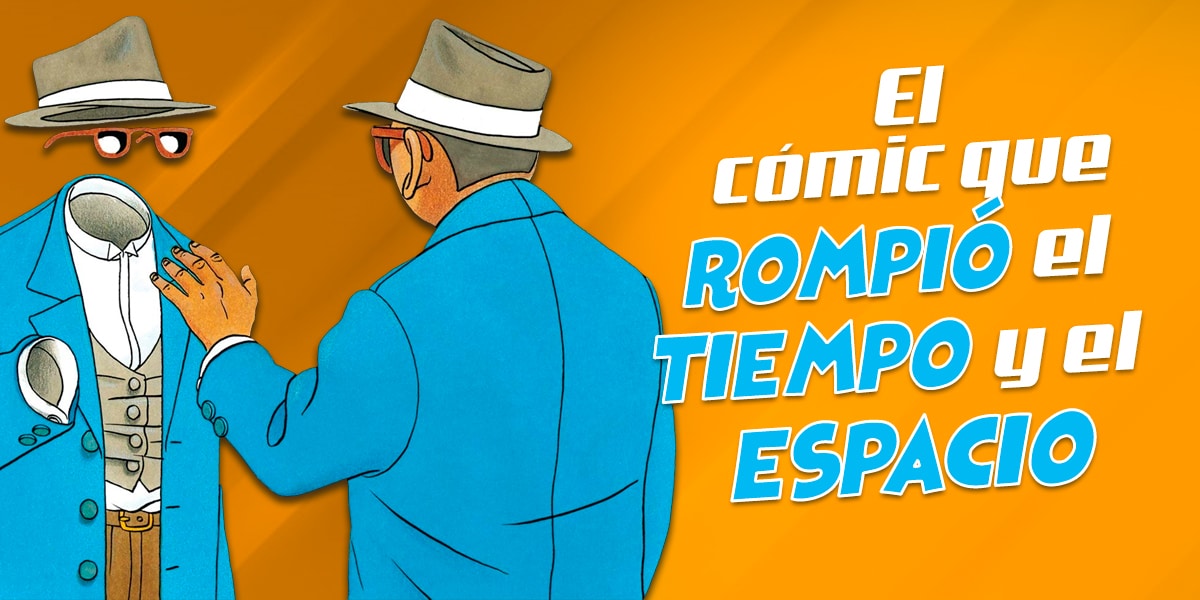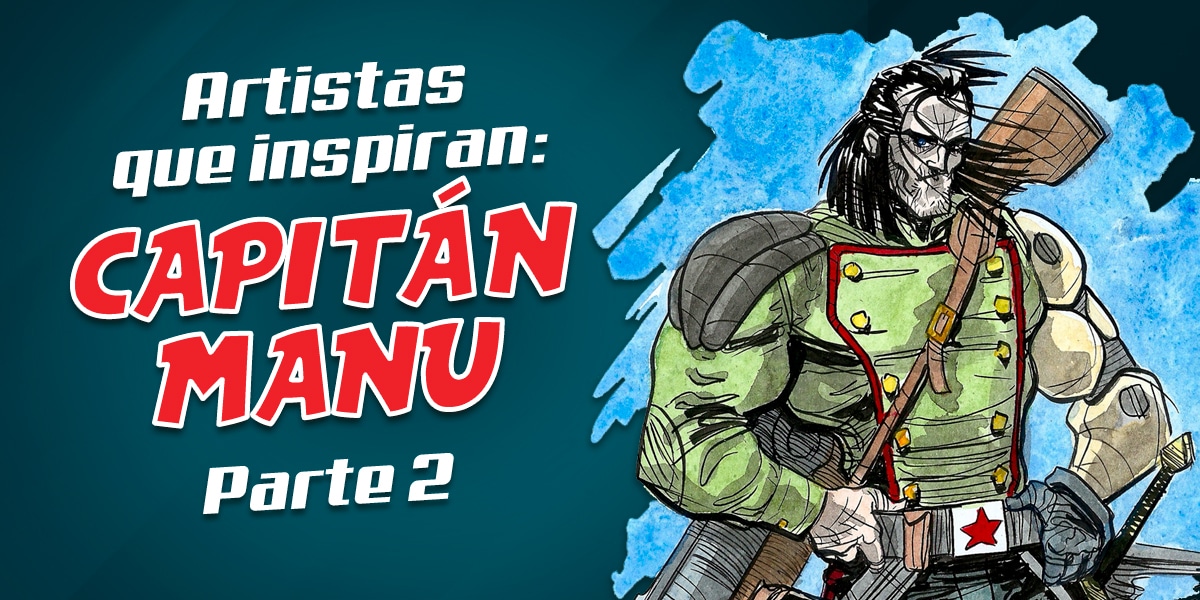La serie de cómics que rompió el tiempo y el espacio
¿Alguna vez has imaginado un cómic que desafíe las leyes de la física, juegue con tu percepción del tiempo y te haga cuestionar la realidad misma? Prepárate para sumergirte en un viaje alucinante a través de las páginas de una obra maestra que revolucionó el mundo de la narrativa gráfica. En este artículo, te presentaremos una serie de cómics que no solo rompió con los esquemas tradicionales, sino que pulverizó las barreras entre dimensiones, dejando a lectores y críticos boquiabiertos.
Desde viajes en el tiempo hasta paradojas espaciales, pasando por juegos de color que desafían la lógica, esta serie te llevará a explorar los límites de tu imaginación y te hará replantearte todo lo que creías saber sobre el arte secuencial. ¿Estás listo para embarcarte en una aventura que desafiará tu mente y expandirá tus horizontes creativos? ¡Continúa leyendo y descubre cómo un artista visionario logró lo imposible!
Por Chuky Rossi
Rompiendo el espacio y el tiempo: Una revolución en la narrativa gráfica
Si crees que lo has visto todo en el mundo de los cómics, prepárate para una sorpresa que sacudirá los cimientos de tu comprensión sobre la narrativa visual. La mayoría de las historias gráficas siguen convenciones establecidas sobre el espacio y el tiempo, presentando sus mundos en dos dimensiones con una progresión lineal de eventos. Sin embargo, un audaz creador ha decidido desafiar estas normas, ofreciendo una experiencia de lectura que trasciende los límites de lo convencional.
Este innovador enfoque no solo replantea cómo se cuenta una historia en viñetas, sino que también cuestiona la naturaleza misma de la realidad dentro del universo del cómic. ¿Quieres llevar tu creatividad al siguiente nivel? Descubre cómo aquí y aprende a desafiar las convenciones en tus propias creaciones.
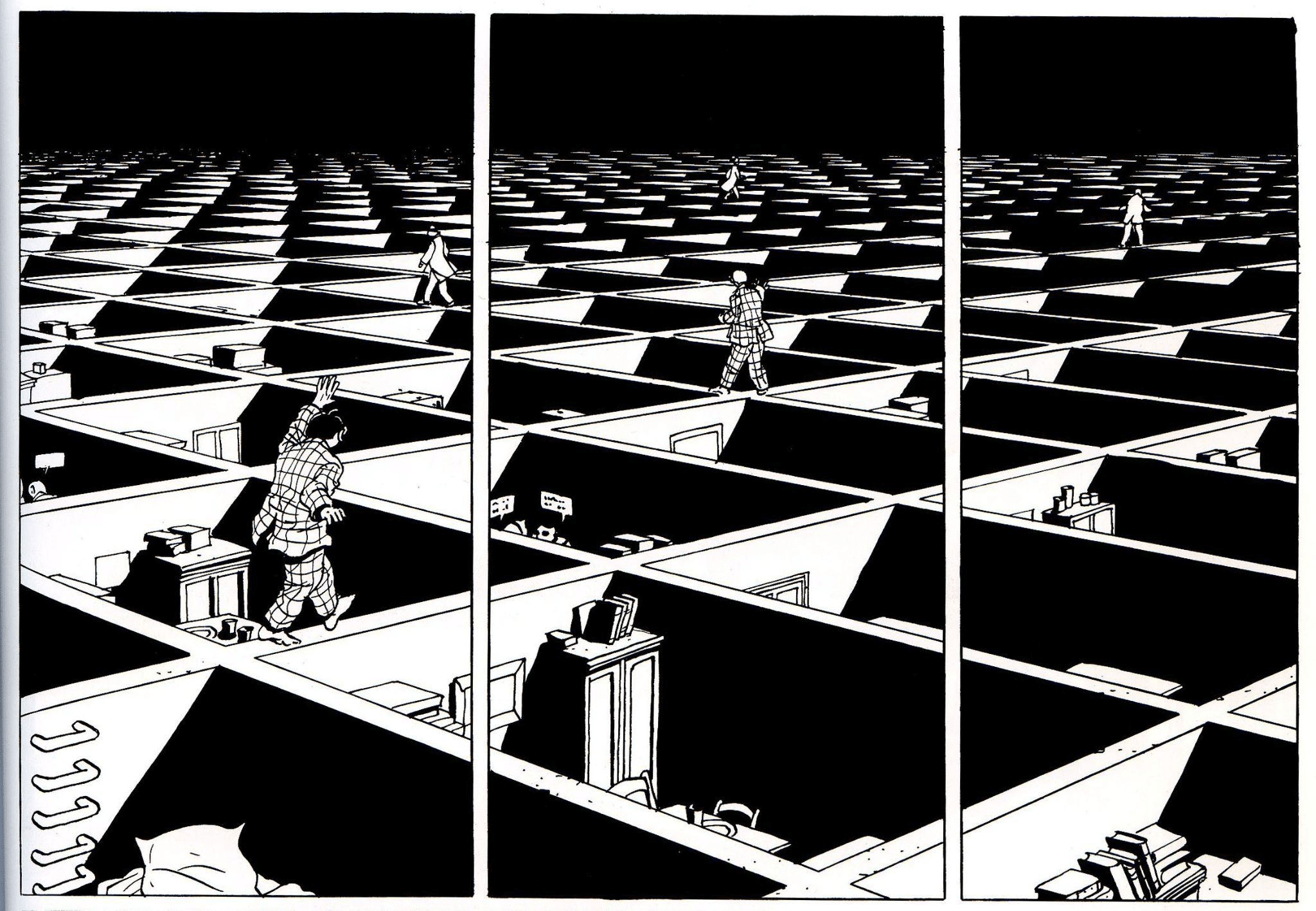
Marc-Antoine Mathieu: El visionario que redefinió los límites del cómic
Marc-Antoine Mathieu, un brillante guionista y dibujante francés, ha creado una serie de cómics experimentales que desafían toda lógica convencional. Su obra maestra, “Julius Corentin Acquefacques, prisionero de los sueños”, es una colección de tomos que exploran las fronteras entre la realidad y la ficción, el sueño y la vigilia, y las dimensiones mismas del universo del cómic.
En cada volumen, Acquefacques, el protagonista, se enfrenta a desequilibrios en su mundo bidimensional que cuestionan la naturaleza misma de su existencia. ¿Está soñando o despierto? ¿Es un personaje o el creador? Estas preguntas se entrelazan con paradojas temporales, espaciales y dimensionales que desafían tanto al personaje como al lector, creando una experiencia de lectura verdaderamente única.
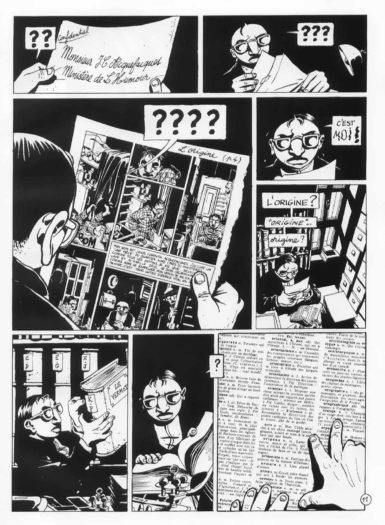
El nombre del personaje principal, Acquefacques, no es casualidad. Pronunciado en francés, suena como “Akfak”, que invertido se convierte en “Kafka”. Este guiño al famoso escritor checo no es accidental, ya que el mundo de Acquefacques comparte muchas similitudes con las narrativas kafkianas: absurdo, onírico, angustioso y envuelto en una atmósfera burocrática con reglas que alteran la vida de sus habitantes.
Mathieu, además, es un gran admirador de Jorge Luis Borges, cuyas obras han influido profundamente en su estilo narrativo. Al igual que Borges en “La biblioteca de Babel”, Mathieu juega con conceptos paradójicos, surrealistas y matemáticos en sus cómics, explorando las infinitas posibilidades de los universos narrativos.
¿Ansioso por explorar nuevas formas de contar historias? Haz clic aquí para ampliar tus horizontes creativos y descubre cómo puedes incorporar elementos innovadores en tus propias narrativas gráficas.
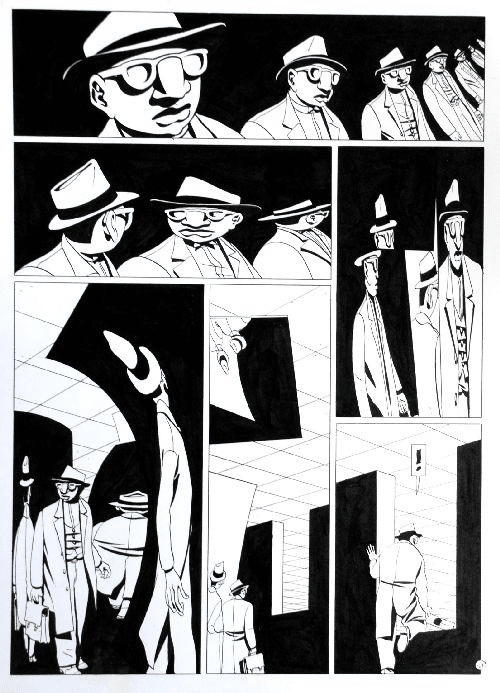
L’Origine: Cuando el pasado, presente y futuro colisionan en una página
“L’Origine” (El Origen, 1990) es el primer volumen de la serie “Julius Corentin Acquefacques” y marca el inicio de un viaje alucinante a través de las dimensiones del cómic. En esta obra, Mathieu nos presenta a Acquefacques, un empleado del surrealista Ministerio del Humor, que descubre que su existencia bidimensional está contenida dentro de un universo tridimensional habitado por su propio creador.
Este mundo, dominado por una burocracia absurda y poblado exclusivamente por hombres, plantea preguntas fascinantes sobre la naturaleza de la creación y el libre albedrío. Mathieu explica que sus personajes, al ser producto de su imaginación, carecen de la capacidad de autogenerarse o reproducirse, convirtiéndolos en seres vacíos sin control sobre su destino.
Lo verdaderamente revolucionario de esta historia es cómo Mathieu juega con la temporalidad. Acquefacques recibe sobres misteriosos que contienen páginas del mismo cómic en el que existe, permitiéndole vislumbrar su pasado, presente y futuro simultáneamente. Este concepto alcanza su punto culminante cuando el lector se encuentra con un agujero literal en una de las páginas, creando una “antiviñeta” que permite ver el contenido de páginas anteriores o posteriores, generando una experiencia de lectura no lineal y multidimensional.
¿Listo para revolucionar tu forma de crear cómics? Ingresa aquí y descubre técnicas innovadoras que te ayudarán a romper los límites convencionales de la narrativa gráfica.
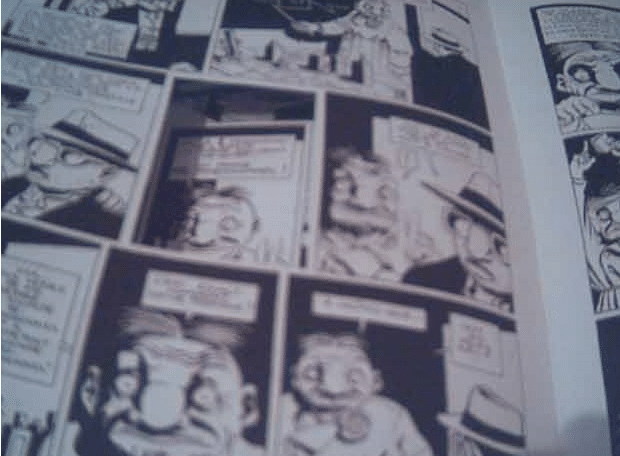
La Qu…: Una explosión de color que desafía la percepción
“La Qu…” (1991), el segundo volumen de la serie, continúa desafiando las convenciones del cómic con un uso innovador y sorprendente del color. El título enigmático, con sus puntos suspensivos, ya anticipa una historia llena de misterios y revelaciones impactantes.
En esta entrega, Acquefacques comienza a cuestionar la naturaleza monocromática de su mundo. A través de sueños o alucinaciones, nuestro protagonista se pregunta si su existencia transcurre únicamente en blanco y negro, como se presentó en el volumen anterior. La respuesta a esta interrogante llega de forma espectacular cuando Acquefacques abre una compuerta en el cielo blanco y descubre que la “Qu…” es, en realidad, la cuatricromía (quadrichromie en francés).
Este momento marca un punto de inflexión en la narrativa, ya que las páginas del cómic explotan repentinamente en un vibrante despliegue de colores. Mathieu utiliza magistralmente la técnica de impresión a cuatro colores (cian, magenta, amarillo y negro) para crear un efecto visual impactante que no solo sorprende al lector, sino que también cuestiona la naturaleza misma de la realidad dentro del universo del cómic.
La transición del blanco y negro al color no es solo un truco visual, sino una metáfora poderosa sobre la expansión de la conciencia y la percepción. Acquefacques, al descubrir el color, está esencialmente descubriendo una nueva dimensión de su existencia, una que siempre estuvo allí pero que permanecía oculta a su comprensión limitada.
¿Quieres dominar el arte del color en tus ilustraciones? Explora más aquí y aprende a utilizar la paleta cromática para crear impacto visual y narrativo en tus obras.
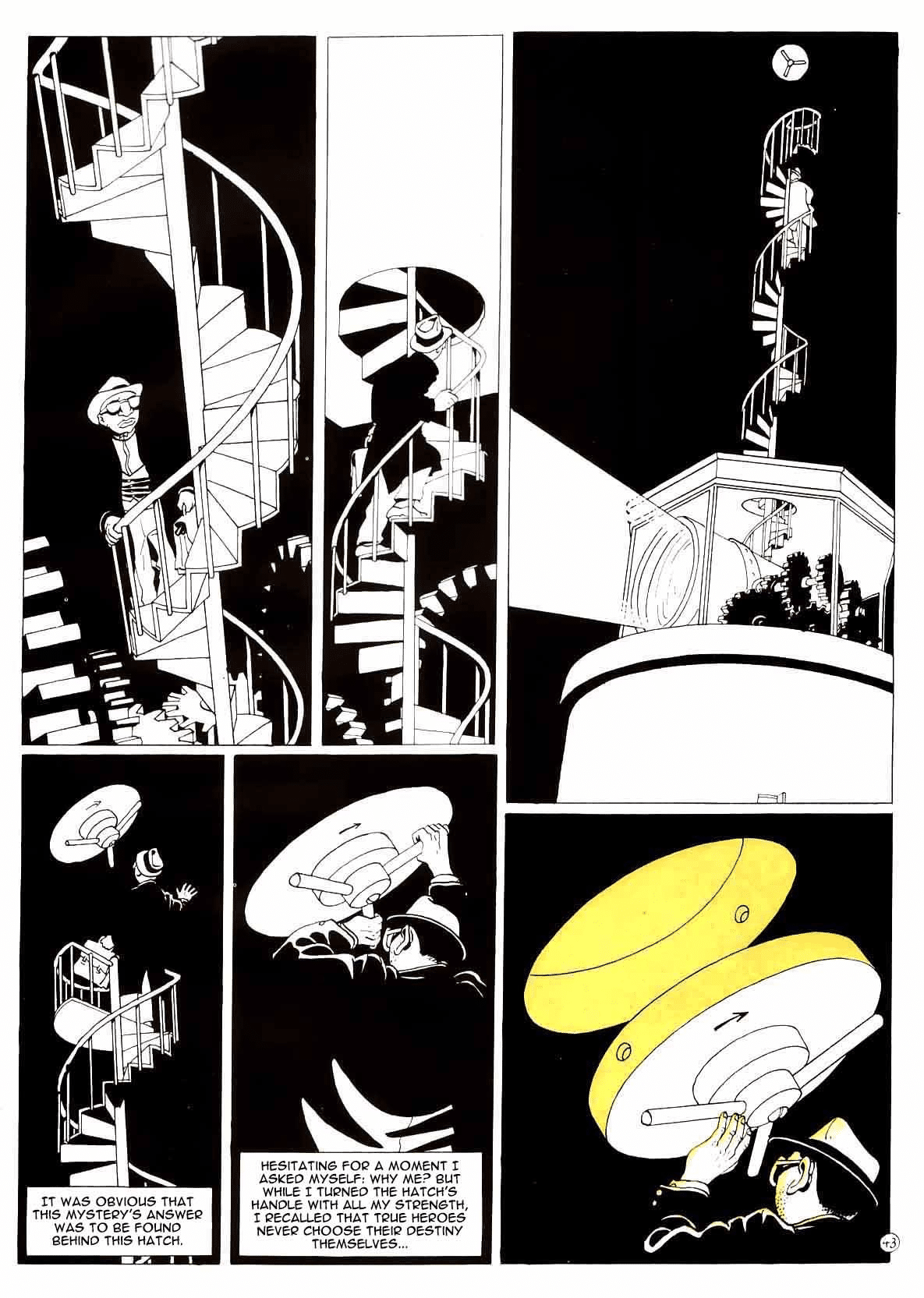
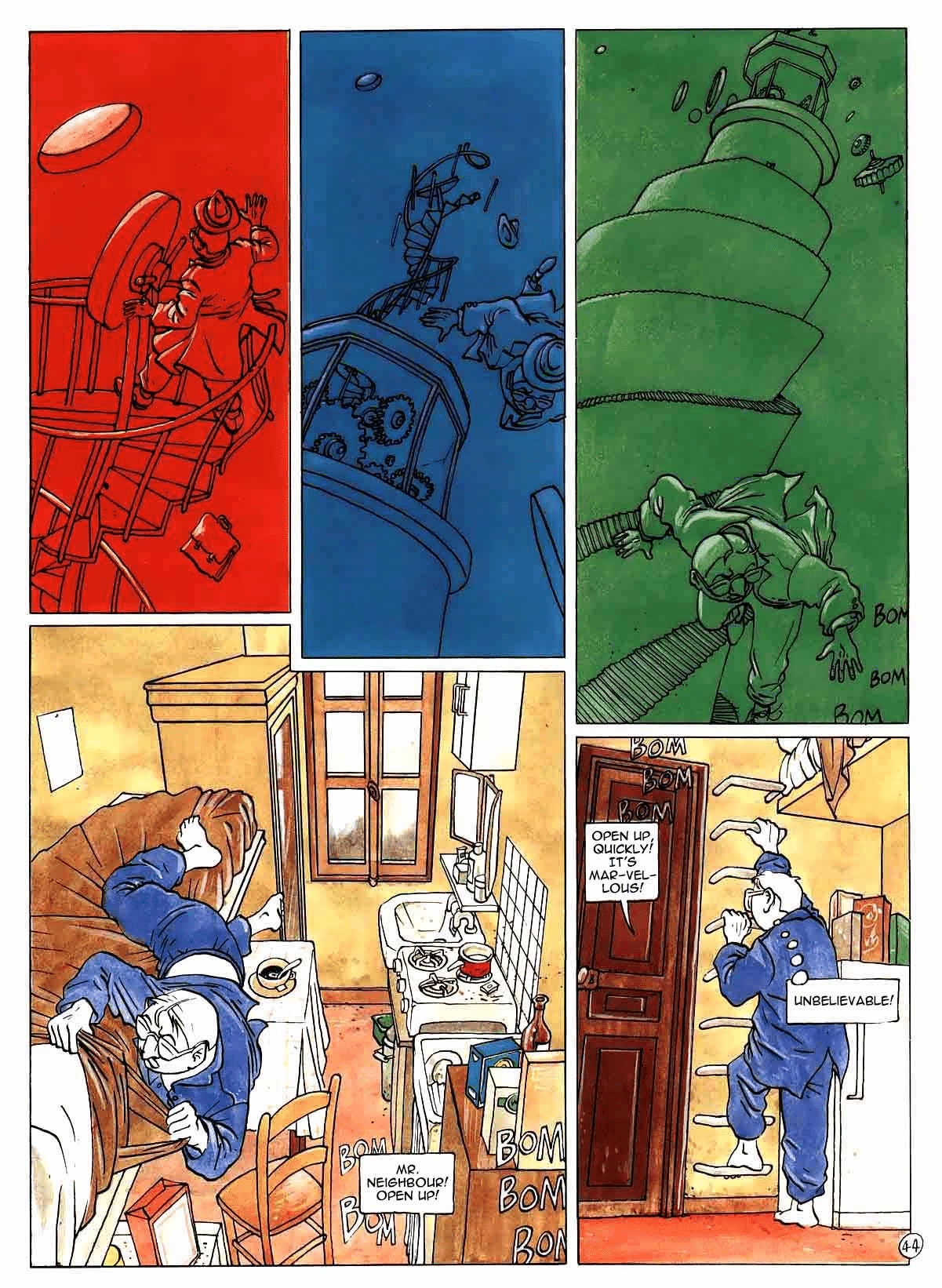
Le Processus: Un vórtice de tiempo y espacio
“Le Processus” (El Proceso, 1993), el tercer tomo de la serie, lleva la experimentación narrativa y visual a nuevas alturas, ofreciendo una de las experiencias más desconcertantes y fascinantes de la colección.
La historia comienza con Acquefacques despertando una mañana para encontrarse con su propio doble, resultado de una alteración temporal que lo hace adelantarse a sí mismo. Este encuentro desencadena una frenética persecución en la que Acquefacques intenta impedir que su doppelgänger asista a una misteriosa reunión.
Sin embargo, la trama da un giro inesperado cuando un vórtice arrastra a nuestro protagonista a un mundo tridimensional, el reino de su creador. Este salto dimensional no solo desafía la comprensión del personaje sobre su propia existencia, sino que también juega con los límites entre la ficción y la realidad, el personaje y el autor.
Aunque Acquefacques logra regresar a su mundo bidimensional, nada vuelve a ser lo mismo. El desfase temporal y espacial ha creado un bucle infinito, condenando al personaje a revivir las mismas acciones una y otra vez en una espiral interminable. Mathieu lleva este concepto al extremo incorporando físicamente una espiral desplegable recortada en una de las páginas del cómic, fusionando así el contenido narrativo con la forma física del libro.
Esta representación visual del bucle temporal no solo es un alarde de ingenio en el diseño editorial, sino que también invita al lector a participar activamente en la experiencia, manipulando físicamente la página para desentrañar el misterio del tiempo cíclico en el que Acquefacques ha quedado atrapado.
¿Te atreves a experimentar con nuevas formas de narración visual? Descubre aquí cómo llevar tus ideas al papel y crear historias que desafíen las expectativas de tus lectores.
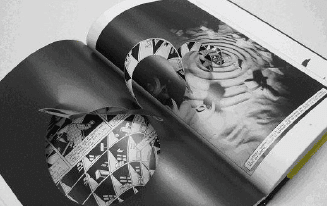
Le Début de la fin: Un espejo que refleja la realidad del cómic
“Le Début de la fin/La fin du début” (El Principio del fin o El Fin del Principio, 1995) es el cuarto tomo de la serie y representa quizás el pináculo de la experimentación narrativa y visual de Mathieu. En esta entrega, el concepto de simetría y reflejo se convierte en el eje central de la historia, llevando al lector a un viaje desconcertante a través de un mundo invertido.
La historia comienza con Acquefacques despertando para descubrir que todas sus acciones ocurren al revés. Este giro narrativo se manifiesta en situaciones absurdas y cómicas, como ponerse el pijama para salir a la calle, desafiando la lógica convencional y creando un sentido de desorientación tanto en el personaje como en el lector.
El punto culminante de esta exploración de la simetría llega en la página central del cómic, donde Acquefacques atraviesa literalmente un espejo. A partir de este momento, la historia se invierte completamente, obligando al lector a releer la misma narrativa pero en sentido contrario. Este ingenioso dispositivo narrativo no solo desafía la forma tradicional de leer un cómic, sino que también cuestiona la naturaleza lineal del tiempo y la realidad.
Mathieu lleva este concepto de inversión más allá de las páginas internas del cómic. En un alarde de creatividad y atención al detalle, diseña la contraportada del libro para que sea completamente simétrica a la portada. Este enfoque holístico de la narrativa visual transforma el libro físico en sí mismo en parte integral de la experiencia de lectura, borrando las líneas entre el contenido y el medio.
¿Inspirado para crear tu propia obra maestra del cómic? Haz clic aquí y comienza tu viaje creativo, explorando técnicas innovadoras que te ayudarán a contar historias de formas nunca antes vistas.
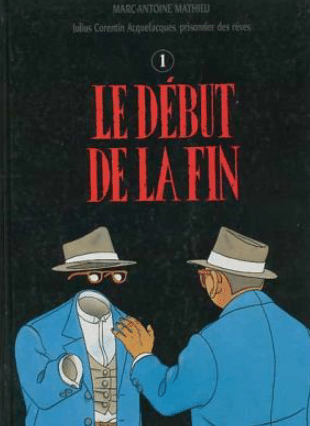
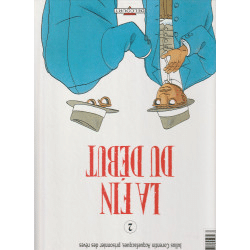
Conclusión: Un viaje sin fin a través de las dimensiones del cómic
La serie “Julius Corentin Acquefacques” de Marc-Antoine Mathieu representa un hito en la historia del cómic, desafiando y expandiendo los límites de lo que es posible lograr en el medio. A través de su innovadora narrativa y su audaz experimentación visual, Mathieu ha creado una obra que trasciende las convenciones del género, invitando a los lectores a un viaje fascinante a través del tiempo, el espacio y las dimensiones de la realidad misma.
Desde la manipulación del tiempo en “L’Origine”, pasando por la explosión de color en “La Qu…”, el bucle temporal de “Le Processus”, hasta la simetría perfecta de “Le Début de la fin”, cada volumen ofrece una experiencia única que desafía nuestras percepcionesy nos invita a repensar la naturaleza misma de la narrativa gráfica.
La genialidad de Mathieu no solo radica en su capacidad para jugar con los conceptos de tiempo y espacio dentro de sus historias, sino también en cómo integra estos elementos en la forma física del cómic. Agujeros en las páginas, espirales desplegables y portadas simétricas son solo algunos ejemplos de cómo el autor fusiona el contenido con el medio, creando una experiencia de lectura verdaderamente inmersiva y multidimensional.
Más allá de su innovación técnica, la serie de Acquefacques plantea preguntas profundas sobre la realidad, la identidad y el libre albedrío. Al colocar a su protagonista en situaciones que desafían la lógica y la física, Mathieu nos invita a cuestionar nuestras propias percepciones del mundo y nuestra place en él. ¿Somos, como Acquefacques, prisioneros de un universo que no comprendemos completamente? ¿Hasta qué punto somos autores de nuestro propio destino?
La influencia de esta serie revolucionaria se extiende más allá del mundo de los cómics. Artistas, escritores y creadores de diversos campos han encontrado inspiración en el trabajo de Mathieu, adoptando sus técnicas innovadoras para desafiar las convenciones en sus propios medios. ¿Listo para revolucionar tu arte? Descubre aquí cómo puedes aplicar estas técnicas innovadoras en tus propias creaciones y llevar tu narrativa visual al siguiente nivel.
Aunque hemos explorado solo una parte de la serie “Julius Corentin Acquefacques”, el viaje está lejos de terminar. Mathieu continúa desafiando los límites de lo posible en el mundo del cómic, llegando incluso a publicar un tomo en 3D que promete llevar la experiencia de lectura a nuevas dimensiones, literalmente. Este constante impulso hacia la innovación nos recuerda que, en el mundo del arte y la narrativa, las únicas limitaciones son las de nuestra propia imaginación.
Al reflexionar sobre la obra de Mathieu, no podemos evitar maravillarnos ante las infinitas posibilidades que ofrece el medio del cómic. Cada página, cada viñeta, se convierte en una oportunidad para desafiar lo convencional y explorar nuevas formas de contar historias. La serie de Acquefacques nos demuestra que, con creatividad y visión, es posible crear obras que no solo entretienen, sino que también expanden nuestra comprensión del arte y la realidad misma.
Te invitamos a sumergirte en el fascinante universo creado por Marc-Antoine Mathieu. Explora cada tomo, desentraña sus misterios y déjate llevar por un viaje que desafiará tu percepción del tiempo, el espacio y la narrativa. Y quién sabe, tal vez te inspires para crear tu propia obra revolucionaria que rompa con todas las convenciones.
¿Estás listo para dar el salto y crear tu propia obra maestra del cómic? Haz clic aquí y comienza tu viaje creativo hoy mismo. Recuerda, en el mundo del arte secuencial, los únicos límites son los que tú mismo te impongas. ¡El futuro del cómic está en tus manos!
Bibliografía
Thierry Groensteen (1998-2002) Julius corentin y yo: entrevista con Marc-Antoine Mathieu
Revista 9ème Art No.4
Macho Stadler Marta (2015) Julius Corentin Acquefacques, prisionero de los sueños. Revista Pensamiento Matemático, Volumen V. España.

